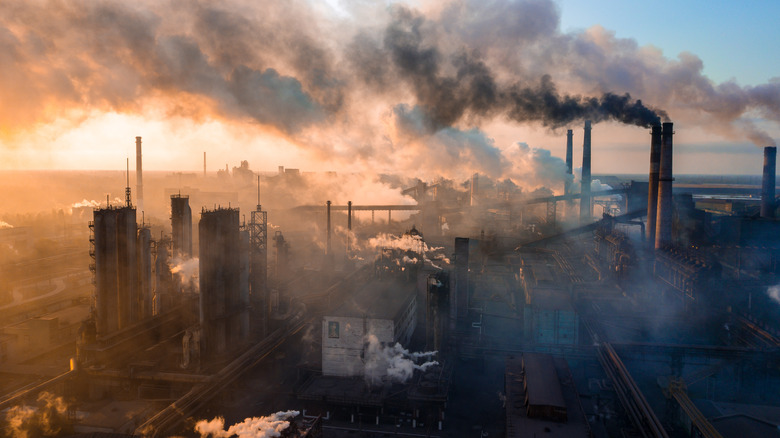These Scientists Believe They've Discovered How To Reverse Climate Change
A team of scientists from MIT believes they've discovered a way to not just pause the devastating effects of climate change but reverse the process entirely. The United Nations describes climate change as "long-term shifts in temperatures and weather patterns" and acknowledges multiple factors can contribute to the phenomenon. Some of these contributors are natural, such as volcanic eruptions and the position of the Earth relative to the sun. However, the main concern is the effect humans are having on global temperatures.
Since the industrial revolution took off in the 19th century, humanity has been burning large amounts of fossil fuels like coal, oil, and gas. Fossil fuels don't burn clean; a number of gases are given off in the process, and some of these have the potential to blanket the Earth and trap heat — these are known as "greenhouse gases." Carbon dioxide and methane are the two main greenhouse gases we currently emit. Practices like deforestation and the use of landfills also exacerbate the problem.
The Earth seems to be more than 1.1 degrees Celsius warmer than it was just over a century ago, with the past year being the hottest globally on record. This may not seem like a lot, but scientists say we are already seeing the effects. Droughts, extreme weather, large forest fires, and rising sea levels are just some of the consequences linked to climate change. Globally, a number of communities have had to relocate. The UN expects the number of climate refugees to increase sharply over the coming decades as areas of the planet become borderline uninhabitable. However, there is hope: it is believed that we can avoid the worst consequences of global warming if temperature rises are kept under 1.5 degrees Celsius ... and plans are in place to do just that.
Current actions may not be enough
With the rate the planet is warming predicted to reach around 3.2 degrees Celsius by 2100, drastic measures have had to be put in place to avoid a climate disaster. One of the most notable actions was the 2015 Paris Agreement, which saw 196 countries take a legally-binding pledge to limit their effects on the planet's climate. Under the agreement, signatories have agreed to try and create a carbon-neutral world by 2050, develop emission-reducing technologies, and provide financial support to those who need it. Progress is tracked in five-year increments, and the ultimate goal is to reduce warming from 3.2 degrees Celsius to "well under" 2 degrees Celsius and preferably under 1.5 degrees Celsius by the end of the century.
The United States, which is currently responsible for just under a quarter of global Co2 emissions, withdrew from the Paris Agreement under the Trump Administration in 2017. The move received heavy criticism from scientists, climate activists, and business leaders, with several major companies voluntarily sticking to plans they adopted while the agreement was in force. The U.S. rejoined the agreement under the Biden Administration in 2021, with the Secretary of State Antony J. Blinken describing it as an "unprecedented framework for global action" and saying, "Addressing the real threats from climate change and listening to our scientists is at the center of our domestic and foreign policy priorities."
Renewable energy use has increased, as has the uptake of zero-emission and low-emission transport solutions like electric vehicles and hybrids. However, there is still a long way to go. In order to hit the 1.5 degrees Celsius target, the UN believes "half of emissions cuts must be in place by 2030" and "fossil fuel use must decline by 6% per year."
Can we reverse climate change entirely?
Drastic reductions in emissions may not be the only way to slow down or stop climate change. Researchers at the Massachusetts Institute of Technology believe they have found a way to negate the effects of global warming or maybe even reverse them entirely. MIT's solution involves the creation of "several thin film-like silicon bubbles" that would then be joined together in space "like a raft." The raft in question would be roughly the size of Brazil and, if the scientists are correct, could provide an extra buffer between the planet and the sun's harmful rays.
Silicon is the material of choice for the bubbles, which would be created in space and frozen before forming part of the shield. They would, of course, degrade, and the rate at which they would have to be replenished is still being studied. The shield would be positioned at the Earth and sun's Lagrangian Point — that is, the point in which the Earth and sun's gravitational forces will act to keep it in position between them. MIT also claims that the method "would not interfere directly with our biosphere and therefore would pose fewer risks to alter our already fragile ecosystems."
It is theorized that if the bubbles "deflect 1.8% of incident solar radiation before it hits our planet," current global warming would be reversed entirely. The concept is based on the work of astronomer Roger Angel who first "proposed using thin reflective films in outer space." But what if it all goes wrong? Apparently, the consequences aren't that serious, as MIT describes the whole process as "easily deployable and fully reversible."


